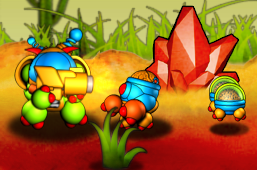

These actions are also used in defence of a gallery by competing males.
#Knight vs giant insects Patch
Pegs or ridges on the side of their abdomen are struck by a patch of fine pegs at the inner surface of their hind legs ( femur) and this action makes a distinctive sound. Tree wētā raise their hind legs into the air in warning to foes, and then bring them down to stridulate. Tree wētā lift their hind legs in a defence displays to look large and spiky, but they tend to retreat if given the chance. Tree wētā bites are painful but not particularly common.
#Knight vs giant insects skin
A wētā takes between one and two years to reach adulthood, and over this time will have to shed its skin around ten times as it grows. Wētā eggs are laid in soil over the autumn and winter months and hatch the following spring. Ground wētā ( Hemiandrus sp.) males provide nuptial food gifts when mating and females of some species provide maternal care. Tree wētā ( Hemideina sp) males have larger heads than females and a polygynandrous mating system with harem formation and male-male competition for mates. Male giant wētā ( Deinacrida sp.) are smaller than females and they show scramble competition for mates. Most wētā are predators or omnivores preying on other invertebrates, but the tree and giant wētā eat mostly lichens, leaves, flowers, seed-heads, and fruit.


They are nocturnal, and all New Zealand species are flightless. Because they can cope with variations in temperature, wētā are found in a variety of environments, including alpine, forests, grasslands, caves, shrub lands and urban gardens. Their physical appearance is like a katydid, long-horned grasshopper, or cricket, but the hind legs are enlarged and usually very spiny. Many wētā are large by insect standards and some species are among the largest and heaviest in the world. In New Zealand English, it is spelled either "weta" or "wētā", although the form with macrons is increasingly common in formal writing, as the Māori word weta (without macrons) instead means "filth or excrement". Wētā is a loanword, from the Māori-language word wētā, which refers to this whole group of large insects some types of wētā have a specific Māori name.


 0 kommentar(er)
0 kommentar(er)
